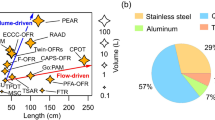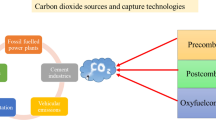Abstract
Two gases, O3 and NO2, were selected to probe the surface of a diesel fuel combustion aerosol sample, diesel soot, and amorphous carbon nanoparticles (PRINTEX XE2-B) using heterogeneous (i.e., gas-surface reactions). The gas uptake to saturation of the probes was measured under molecular flow conditions using a Knudsen flow reactor in order to quantify and characterize surface functional groups. Specifically, O3 and NO2 are used for the titration of oxidizable groups. Diesel soot samples interacted with the probe gases to various extents which points to the coexistence of different functional groups on the same aerosol surface such as reduced groups. The carbonaceous particles displayed significant differences: PRINTEX XE2-B amorphous carbon had a significantly lower surface functional group density of both total and strongly reducing groups despite its significantly larger internal surface area, compared to diesel soot. The uptake kinetics of the gas-phase probe molecules (uptake probabilities) were also measured in order to obtain further information on the reactivity of emitted soot aerosols in order to enable the potential prediction of health effects.






Similar content being viewed by others
References
Baulig A, Sourdeval M, Meyer M, Marano F, Baeza-Squiban A (2003) Biological effects of atmospheric particles on human bronchial epithelial cells. Toxicol in Vitro 17:567–573
Berg JM, Shu H, Hwang W, Zebda R, Cummins K, Soriaga MP, Taylor R, Guo B, Sayes CM (2010) Internalization of carbon black and maghemite iron oxide nanoparticle mixtures leads to oxidant production. Chem Res Toxicol 23:1874.1882
Boehm HP (2002) Surface oxides on carbon and their analysis: a critical assessment. Carbon 40:145–49
Boehman AL, Song J, Alam M (2005) Impact of biodiesel blending on diesel soot and the regeneration of particulate filters. Energ Fuel 19:1857–1864
Braun A, Shah N, Huggins FE, Kelly KE, Sarofim A, Jacobsen C, Wirick S, Francis H, Ilavsky J, Thomas GE, Huffman GP (2005) X-ray scattering and spectroscopy studies on diesel soot from oxygenated fuel under various engine load conditions. Carbon 43:2588–2599
Cain JP, Gassmn PL, Wang H, Laskin A (2010) Micro-FTIR study of soot chemical composition-evidence of aliphatic hydrocarbons on nascent soot surfaces. Phys Chem Chem Phys 12:5206–5218
Caloz F, Fenter FF, Tabor KD, Rossi MJ (1997) Paper I: Design and construction of a Knudsen-cell reactor for the study of heterogeneous reactions over the temperature range 130-750 K: Performances and limitations. Rev Sci Instrum 68(8): 3172--3179
Davidson CJ, Phalen RF, Solomon PA (2005) Airborne particulate matter and human health. Aerosol Sci Tech 39:737–749
Dorado MP, Ballesteros E, Arnal JM, Gómez J, López FJ (2003) Exhaust emissions from a diesel engine fueled with transesterified waste olive oil. Fuel 82(11):1311–1315
Gaffney JS, Marley NA (2009) The impacts of combustion emission on air quality—from coal and biofuels and beyond. Atmos Environ 43:23–36
Giordana A, Maranzana A, Ghigo G, Causà M, Tonachini G (2008) Soot platelets and PAHs with an odd number of unsaturated carbon atoms and π electrons: theoretical study of their spin properties and interaction with ozone. J Phys Chem A 112(5):973–982
Giordana A, Maranzana A, Ghigo G, Causà M, Tonachini G (2011) Border reactivity of polycyclic aromatic hydrocarbons and soot platelets toward ozone A theoretical study. J Phys Chem A 115(4):470–481
Graboski MS, McCormick RL (1998) Combustion of fat and vegetable oil derived fuels in diesel engines. Prog in Energ Combus 24:125–164
Harley RA, Marr LC, Lehner JK, Giddings SN (2005) Changes in motor vehicle emissions on diurnal to decadal time scales and effects on atmospheric composition. Environ Sci Tech 39(14):5356–5362
Lapuerta M, Armas O, Ballesteros R (2002) Diesel particulate emissions from biofuels derived from Spanish vegetable oils. SAE paper 2002-01-1657:1–7.
Monge ME, D’Anna D, Mazri L, Giroir-Fendler A, Ammann M, Donaldson DJ, George C (2010) Light changes the atmospheric reactivity of soot. PNAS,107 (15): 6605–6609.
Muckenhuber H, Grothe H (2006) The heterogeneous reaction between soot and NO2 at elevated temperature. Carbon 44:546–559
Muckenhuber H, Grothe H (2007) A DRIFTS study of the heterogeneous reaction of NO2 with carbonaceous materials at elevated temperature. Carbon 45(2):321–329
Sadezky A, Muckenhuber H, Grothe H, Niessner R, Pöschl U (2005) Raman microspectroscopy of soot and related carbonaceous materials: spectral analysis and structural information. Carbon 43(8):1731–1742
Salgado MS, Rossi MJ (2002) Flame soot generated under controlled combustion conditions: heterogeneous reaction of NO2 on hexane soot. Int J Chem Kinet 34(11):620–631
Setyan A (2009) University of Lausanne, Faculté de biologie et de medicine, Institut universitaire romand de Santé au Travail (IST). PhD thesis. https://serval.unil.ch/resource/serval:BIB_51D481F0F365.P001/REF
Setyan A, Sauvain JJ, Riediker M, Guillemin M, Rossi MJ (2009a) Characterization of surface functional groups present on laboratory-generated and ambient aerosol particles by means of heterogeneous titration reactions. J Aerosol Sci 40:534–548
Setyan A, Sauvain JJ, Rossi MJ (2009b) The use of heterogeneous chemistry for the characterization of functional groups at the gas/particle interface of soot and TiO2 nanoparticles. Phys Chem Chem Phys 11:6205–6217
Setyan A, Sauvain JJ, Guillemin M, Riediker M, Demirdjian B, Rossi MJ (2010) Probing functional groups at the gas-aerosol interface using heterogeneous titration reactions a tool for predicting health effects? ChemPhysChem 11:3823–3835
Steiner S, Czerwinski J, Comte P, Popovicheva O, Kireeva E, Müller L, Heeb N, Mayer A, Fink A, Rothen-Rutishauser B (2013) Comparison of the toxicity of diesel exhaust produced by bio- and fossil diesel combustion in human lung cells in vitro. Atmos Environ 81:380–388
Stratakis GA, Stamatelos AM (2003) Thermogravimetric analysis of soot emitted by a modern diesel engine run on catalyst-doped fuel. Combust Flame 132:157–169
Tabor K, Gutzwiller L, Rossi MJ (1994) Heterogeneous chemical kinetics of NO2 on amorphous carbon at ambient temperature. J Phys Chem 98:6172–6186
Wang WG, Lyons DW, Clark NN, Gautam M, Norton PM (2000) Emissions from nine heavy trucks fueled by diesel and biodiesel blend without engine modification. Environ Sci Tech 34(6):933–939
Wentzel M, Gorzawski H, Naumann K-H, Saatho H, Weinbruch S (2003) Transmission electron microscopical and aerosol dynamical characterization of soot aerosols. Aerosol Sci 34:1347–1370
Weast RC, Lide DR (1989) CRC Handbook of Chemistry and Physics. CRC Press Inc, Boca Raton FL, 70th edn
Acknowledgment
This work was supported by project COST CM0901 detailed chemical kinetic models for cleaner combustion.
Author information
Authors and Affiliations
Corresponding author
Additional information
Responsible editor: Constantini Samara
Rights and permissions
About this article
Cite this article
Tapia, A., Salgado, M.S., Martín, M.P. et al. The use of heterogeneous chemistry for the characterization of functional groups at the gas/particle interface of soot from a diesel engine at a particular running condition. Environ Sci Pollut Res 22, 4863–4872 (2015). https://doi.org/10.1007/s11356-014-2976-7
Received:
Accepted:
Published:
Issue Date:
DOI: https://doi.org/10.1007/s11356-014-2976-7




